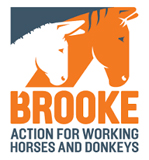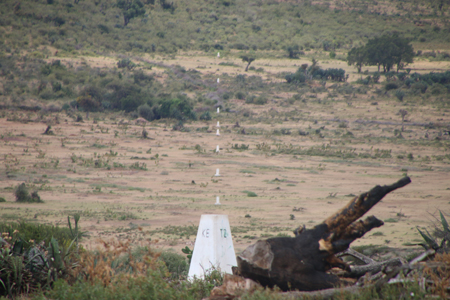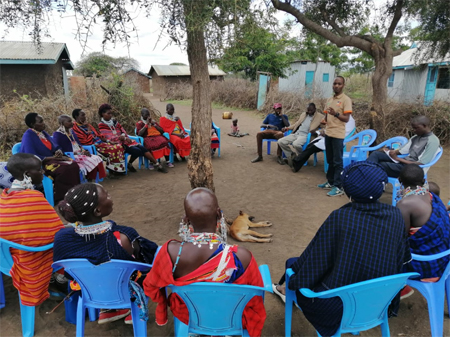ANAW-BROOKE EA DONKEY PROJECT – PHASE ONE
Preamble
 In July 2019 – March 2020, Africa Network for Animal Welfare (ANAW) partnered with Brooke East Africa (EA) to undertake a project dubbed, ‘Addressing Illegal Cross Border Movement of Donkeys on The Kenya-Tanzania Border’. The geographical area was Kajiado and Narok Counties in Kenya while in Tanzania, the project focused on Longido, Sanya, Tarakea and Mgagao districts.
In July 2019 – March 2020, Africa Network for Animal Welfare (ANAW) partnered with Brooke East Africa (EA) to undertake a project dubbed, ‘Addressing Illegal Cross Border Movement of Donkeys on The Kenya-Tanzania Border’. The geographical area was Kajiado and Narok Counties in Kenya while in Tanzania, the project focused on Longido, Sanya, Tarakea and Mgagao districts.
The overall goal of this project was to achieve a disruption of illegal cross-border movement and the donkey hide trade along the Kenya-Tanzania border. ANAW was to collect relevant information on the ground in order to establish the existence, nature and extent of cross-border movement of donkeys between Kenya and Tanzania, resulting to donkey slaughter and skin trade. This information was to be presented to relevant authorities at the county, national and East African region who would in turn facilitate policy change and administrative actions.
Similarly, ANAW and other non-governmental organizations would additionally use the information for advocacy and public awareness. Working with the communities and other stakeholders in the border points, the project would also inform interventions to curb any illegal movements and regulate cross border donkey trade through policy and community actions.
 The specific objectives of the project were six-fold:
The specific objectives of the project were six-fold:
- To establish the existence, nature and extent of cross-border movement of donkeys between Kenya and Tanzania.
- To Sensitize the Community on the donkey trade and its effects on their livelihoods; and empower them in order to address any animal welfare issues resulting from the nature and structure of donkey trade.
- To establish gaps on existing laws and policies on donkey cross-border movement and trade (formal or informal).
- To create awareness within the media on the donkey trade and its effects on community livelihoods.
- To advocate with the county assemblies for the formulation of policies and regulations that discourage the illegal donkey cross-border movement.
- Develop an easy-to-read publication on the overall findings of the project.
Implementation
The project achieved the following three outcomes to meet the goals and objectives, thus:
- Nature and structure of donkey movement and trade across the border (Kenya and Tanzania) was fully understood.
- There was robust and continuous media involvement and coverage in the campaigns against cross-border movement of donkeys, slaughter and skin trade.
- There was development of Policy and legislation, advocacy and petitions at county level as well as policy brief that was shared to the national government officials and other key policy makers/stakeholders for implementation.
By the end of the project life, the following results were achieved as thus;
- The project established that there existed significant movement of donkeys along the Kenya Tanzania border, with approximately 100 donkeys moving from Tanzania to Kenya every day destined for the donkey abattoirs. This was because donkey traders in both Tanzania and Kenya considered this a lucrative trade since they got better prices across the border in Kenya. It was noted that the movement was largely illegal, through undefined and unofficial routes that evaded the formal border crossing points. Seven (7) unofficial routes were identified along the Kenya-Tanzania border stretch that included Ololaimutia, Olposimoru, Ilkerin, Shompole, Namanga, Olgulului and Olmapinu.
- Stakeholders’ workshop bringing together Kenyans and Tanzanians was held in which pertinent issues touching on the plight of donkeys were deliberated and way forward documented. As a result, key donkey welfare stakeholders from both Kenya and Tanzania are discussing ways of curbing the cross-border trade.
- A donkey vaccination clinic, school visit and leader’s sensitization with the support of Kajiado County Director of Veterinary Services were conducted in Magadi, Kajiado county, courtesy of the project. A total of 305 donkeys were vaccinated against rabies, dewormed and their wounds managed.
- The project realized concerted community discussion forum in Narok and Kajiado counties to highlight the plight of donkeys destined for slaughter and the perils associated with trade in donkey skin and meat.
- There was extensive media activity as a result of this project which included print, electronic and social media. The peak was a media stakeholders’ workshop that brought together journalists from Kenya and Tanzania to ventilate the matter of donkey slaughter and its effects on the donkey owning communities in the two countries. An acclaimed and elaborate expose on the donkey slaughter dubbed #HideousBurden was also done in collaboration with NTV courtesy of this project.
- Four donkey owners’ forums (Ololaimutia, Olposimoru, Magadi and Rombo) have been established bringing together more than 130 community members in both Kajiado and Narok counties and are now actively engaged in surveillance and monitoring of the donkey welfare in their localities. Further, these forums have made presentation of community petitions in Narok and Kajiado calling for a total ban on donkey slaughter in Kenya.
- The project led to the Development of a Policy Brief and easy to read publication on the laws and regulations on donkey movement in both Kenya and Tanzania.
Conclusion
Project’s findings showed that due to the porous nature of Kenya Tanzania border especially on Kajiado and Narok Counties border points, the no-tell difference between the Kenyan and Tanzanian Maasai nation who dominate residence on the border points, coupled with broken border surveillance catalysed unchecked cross-border movement and illegal trade of donkeys. Again, project’s research and intelligence indicated that all the donkeys that crossed the border (about 100 in a day) were normally stolen from Tanzania. This, in effect, had caused untold suffering to the communities living near the border and also relying on the animal for their livelihoods as the unscrupulous traders stole their donkeys along the way to their destinations – slaughterhouses, to add up onto their plunder from Tanzania.
It was the considered view of the project that if the existing chain of donkey cartels was not broken, donkey trade halted, and donkey abattoirs closed, these communities would continue to suffer and wallow in abject poverty, hence losing their human dignity.
Further the project adequately established that (by their own admission,) in the Maasai community viewpoint, donkeys served as 1) Maasai’s mobility means 2) Maasai’s second wife and 3) part of the family.
ANAW_BROOKE EA DONKEY PROJECT – PHASE TWO
Title: Building resilience and capacity of donkey owning communities and grass-root government officials for increased vigilance on donkey movement along the Kenya-Tanzania border.
Duration: 8 months (August 2020 – March 2021) – ongoing.
Preamble
 Demand for donkey skin has been on the increase causing a global crisis on the population of donkeys. China is one of the major importers of the skins which is used to make ejiao, a traditional Chinese remedy believed to have medicinal properties. Donkeys population in East Africa continue to dwindle yet resource poor communities depend on them to transport water, wood for cooking, food, and other goods, as well as people. This is disrupting those communities’ livelihoods further plunging them into poverty. The East African region has seen an influx of donkey smuggled across the borders, mostly to Kenya due to licensing of four abattoirs: Goldox Kenya Ltd, Star Brilliant, Silzha Ltd and Fuhai Machakos Trading Co. Ltd, but with the withdrawal of donkey slaughter licenses in Kenya, the traders may turn to Tanzania to continue with the lucrative business as they monitor the situation in Kenya on whether the abattoir licenses will be reinstated. Tanzania has two abattoirs; Fang Hua (Pty) Ltd and Wach International (Pty) Ltd. However, only Fang Hua (Pty) Ltd donkey abattoir in Shinyanga is currently operational. This trade has continued to cause immense suffering of donkeys which are transported in trucks for days without being availed proper feed and water leading to starvation and death of others before arrival to destined slaughterhouses. Further, donkey theft along the border communities, which has been largely undocumented, has been on the rise being partly fueled by illegal movement. There have also being reported cases of inhumanely donkey bush slaughter and harvesting of their skins.
Demand for donkey skin has been on the increase causing a global crisis on the population of donkeys. China is one of the major importers of the skins which is used to make ejiao, a traditional Chinese remedy believed to have medicinal properties. Donkeys population in East Africa continue to dwindle yet resource poor communities depend on them to transport water, wood for cooking, food, and other goods, as well as people. This is disrupting those communities’ livelihoods further plunging them into poverty. The East African region has seen an influx of donkey smuggled across the borders, mostly to Kenya due to licensing of four abattoirs: Goldox Kenya Ltd, Star Brilliant, Silzha Ltd and Fuhai Machakos Trading Co. Ltd, but with the withdrawal of donkey slaughter licenses in Kenya, the traders may turn to Tanzania to continue with the lucrative business as they monitor the situation in Kenya on whether the abattoir licenses will be reinstated. Tanzania has two abattoirs; Fang Hua (Pty) Ltd and Wach International (Pty) Ltd. However, only Fang Hua (Pty) Ltd donkey abattoir in Shinyanga is currently operational. This trade has continued to cause immense suffering of donkeys which are transported in trucks for days without being availed proper feed and water leading to starvation and death of others before arrival to destined slaughterhouses. Further, donkey theft along the border communities, which has been largely undocumented, has been on the rise being partly fueled by illegal movement. There have also being reported cases of inhumanely donkey bush slaughter and harvesting of their skins.
An earlier project implemented by ANAW with Brooke’s financial support, showed that donkeys were smuggled along unofficial routes, mostly from Tanzania headed to Kenyan slaughterhouses. Further, the project showed that many households chose not to report theft incidences to law enforcement agencies since they felt that there would be no redress from local authorities. First, they felt helpless when their donkeys were stolen because that affected their livelihoods, and on the other hand they did not trust the law enforcement agencies. Further, it was not clear why the local administration – assistant chiefs and chiefs – were not actively involved in addressing the menace. By creating a link between communities, the local administration and law enforcement officers, information would flow easily hence triggering urgent action by the local authorities. This would increase vigilance by all parties hence disrupting illegal movement of donkeys and the skin trade.
Goal and objective of the project
The goal of the project is building resilience and capacity of donkey owning communities and grass-root government officials for increased vigilance on donkey movement along the Kenya-Tanzania border to curtail illegal movement and rampant theft. Through donkey forums and key local information networks established in the previous project, targeted education and capacity building activities will be a key component while integrating diversity and the role of different groups within the community for accomplishment of the overall desired outcomes.
The project is also empowering the local administration within Kajiado and Narok counties with knowledge and skills about the donkey skin trade and its implication on communities, including ways of enhancing reporting and data collection of reported theft and movement incidences. This is being incorporated through creating a reporting chain with data collection tools to be adopted by the local authorities. Further, the project is engaging and empowering law enforcement officers living with communities and those working at the Kenya-Tanzania border on the current prevailing legal notice 63 and its enforcement.
The project is facilitating discussions between established donkey forums, diverse community members, local authorities and law enforcement officers – including officials from anti-stock theft unit - with an aim of facilitating creation of a robust link between the key stakeholders that will increase confidence among the parties leading to reporting of illegal movement and theft of donkeys.
Other indirect beneficiaries of the project are the public and policy makers who will receive information about illegal donkey movement and skin trade through media houses messaging. This will further increase conversations on the donkey agenda both at county and national level. By continued conversations by the public and pressure from the media, it is expected that policy makers will act by permanently closing donkey abattoirs.
Importantly, by empowering, engaging, and establishing close links among all actors affected by the donkeys’ illegal movement and skin trade in both Narok and Kajiado counties, the project aims at institutionalizing the donkey agenda within routine chief barazas and other community forums further encouraging similar discussions after decommissioning the project. This project links with ANAW’s programs on capacity building and education; including animal care program such as vaccination activities involving communities.
By the end of the project life, March 2021, it is expected that;
- Donkey owning communities and local authorities along the Kenya-Tanzania border will have increased resilience and vigilance to protect donkeys from theft.
- There will be increased and impactful media involvement and coverage in campaigns against illegal movement of donkeys and skin trade.
